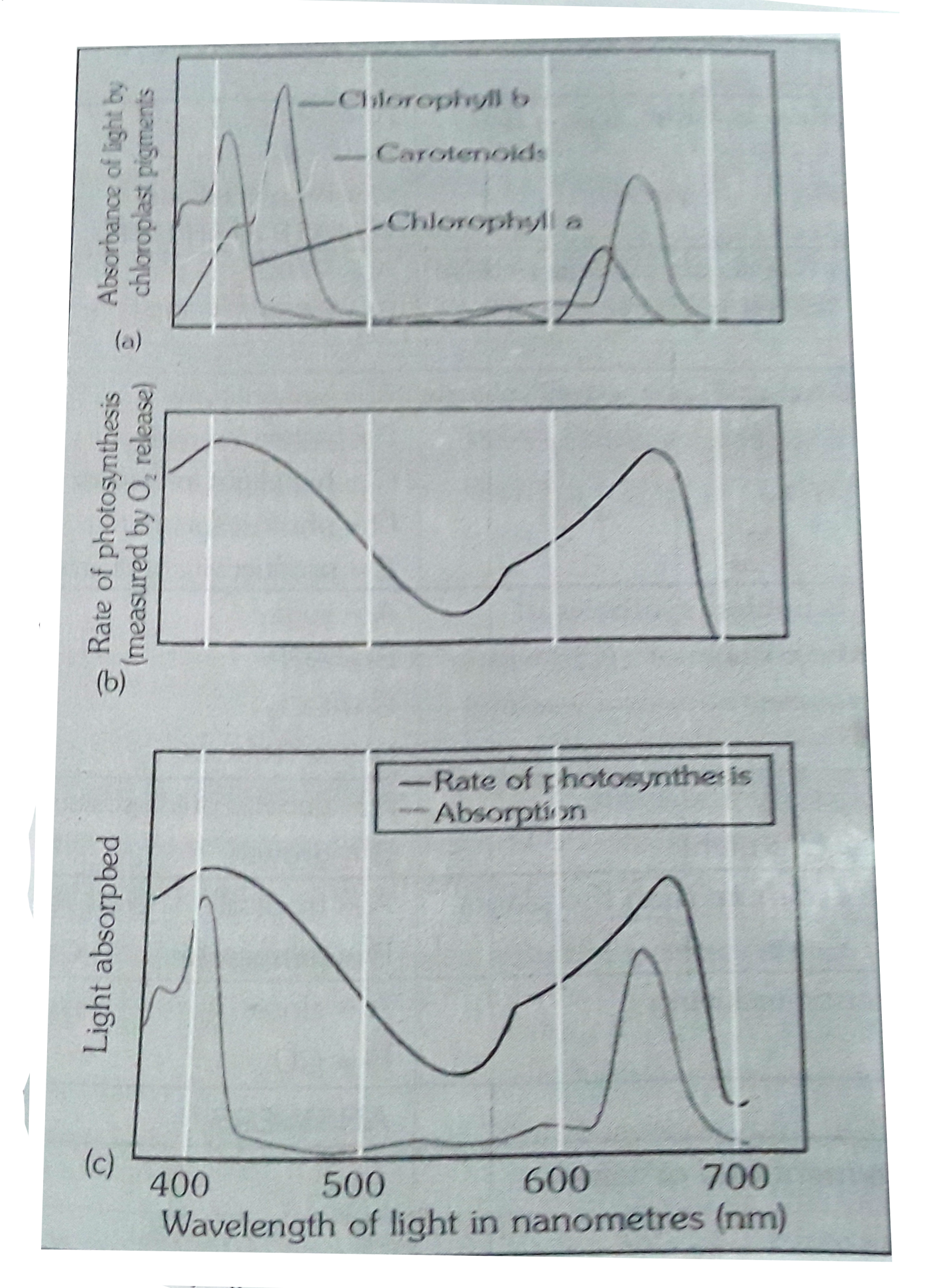In PS I, the reaction centre chlorophyll a has an absorption peak at
650 nm
660 nm
680 nm
700 nm.
The correct Answer is:D
To solve the question regarding the absorption peak of chlorophyll a in Photosystem I (PS I), we can follow these steps:
Step 1: Understand the context of Photosystems
Photosystems are complexes in plants that play a crucial role in photosynthesis. There are two main types: Photosystem I (PS I) and Photosystem II (PS II). Each has a specific role in the light-dependent reactions of photosynthesis.
Hint: Remember that PS I and PS II are named based on the order of their discovery, not their function.
Step 2: Identify the absorption peaks of chlorophyll a
Chlorophyll a is the primary pigment involved in photosynthesis, and it has specific absorption peaks. For PS I, the absorption peak is significant for capturing light energy.
Hint: Look for the specific wavelengths associated with chlorophyll a in both PS I and PS II.
Step 3: Recall the specific absorption peak for PS I
The absorption peak for chlorophyll a in PS I is at 700 nm. This is also why it is referred to as P700.
Hint: Remember that the naming convention (P700) indicates the wavelength at which the pigment absorbs light most effectively.
Step 4: Compare with PS II
For context, PS II has an absorption peak at 680 nm, known as P680. This comparison helps clarify the distinction between the two photosystems.
Hint: Knowing the absorption peaks of both PS I and PS II can help reinforce your understanding of their functions in the light-dependent reactions.
Step 5: Conclude with the answer
Based on the information gathered, the absorption peak of the reaction center chlorophyll a in PS I is 700 nm.
Final Answer: The absorption peak of chlorophyll a in Photosystem I (PS I) is at 700 nm.
Photosystems are complexes in plants that play a crucial role in photosynthesis. There are two main types: Photosystem I (PS I) and Photosystem II (PS II). Each has a specific role in the light-dependent reactions of photosynthesis.
Chlorophyll a is the primary pigment involved in photosynthesis, and it has specific absorption peaks. For PS I, the absorption peak is significant for capturing light energy.
The absorption peak for chlorophyll a in PS I is at 700 nm. This is also why it is referred to as P700.
For context, PS II has an absorption peak at 680 nm, known as P680. This comparison helps clarify the distinction between the two photosystems.
Based on the information gathered, the absorption peak of the reaction center chlorophyll a in PS I is 700 nm.
Topper's Solved these Questions
- PHOTOSYNTHESISBOOK - DINESH PUBLICATION ENGLISHCHAPTER - PHOTOSYNTHESISEXERCISE - CYG
10 Videos
- ORIGIN OF LIFE BOOK - DINESH PUBLICATION ENGLISHCHAPTER - ORIGIN OF LIFE EXERCISE - All Questions
201 Videos
- PHYLUM - ANNELIDABOOK - DINESH PUBLICATION ENGLISHCHAPTER - PHYLUM - ANNELIDAEXERCISE - Check your grasp
10 Videos
Similar Questions
In photosystem I, the reaction centre is
View SolutionObserve the following graphs carefully and select the true or false statement regarding it:-

(i) Graph a indicates that at wavelength of blue and red color, chlorophyll a shows maximum absorption.
(ii) Graph b indicates that at wavelengths of blue and red color, plants shows maximum rate of photosynthesis.
(iii) Graph c indicates complete one to one overlap between the absorption spectrum of chlorophyll a and the action spectrum of photosynthesis.
View Solution
Knowledge Check
In PS I, the reaction centre chl a has absorption maxima at____whereas in PS II, the reaction centre Chl a has absorption maxima at ___
A700nm ,680nmB680nm,700nmC400nm,500nmD700nm,800nm
Complete the following by filling in the blanks numbered 1 to 10 with the appropriate word/ term:
Photosynthesis involves a light reaction and a dark reaction. During the light reaction, the chlorophyll present in the
______ ions are picked up by NADP to form
View SolutionPS I is inactive at
View SolutionStudy of light absorption by chlorophyll is
View SolutionRead the following statements and choose correct ones- (A) Carotenoids protect chlorophyll a from photooxidation, (B) Dark reactions are not directly light driven, ©Chlorophyll a molecule shows maximum absorption in red and blue regions of the visible spectrum of light, (D) Light harvesting complexes are composed of hundreds of pigment molecules bound to lipids only.
View SolutionGive an example of a reaction where the following are involved
Absorption of heat
View SolutionRead the following statements and choose the correct ones.
A. Carotenoids protect chlorophyll a from photo-oxidation.
B. Dark reactions are not directly light driven.
C. Chlorophyll a molecule shows maximum absorption in red and blue regions of the visible spectrum of light.
D. Light harvesting complexes are composed of hundreds of pigment molecules bound to lipids only
View SolutionReaction centre of photosyngthesis is formed of
View Solution
